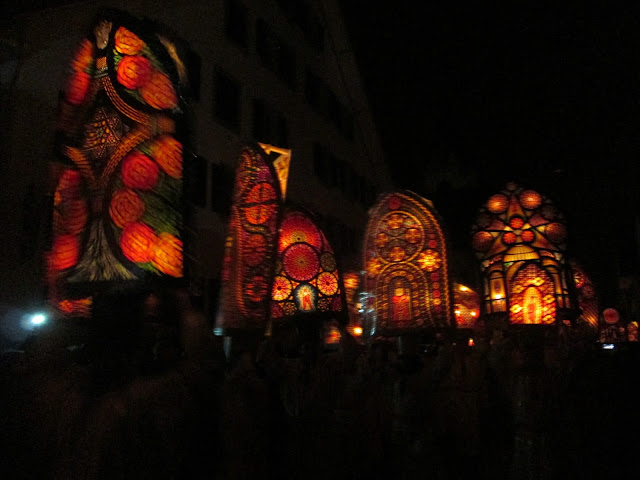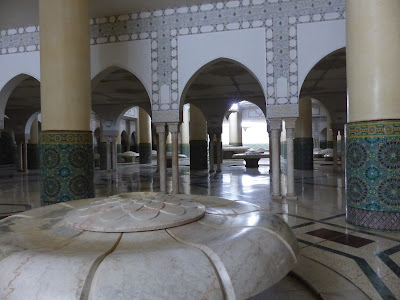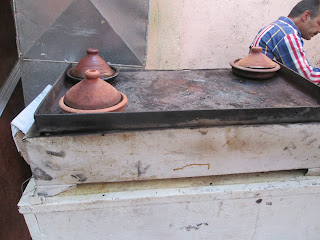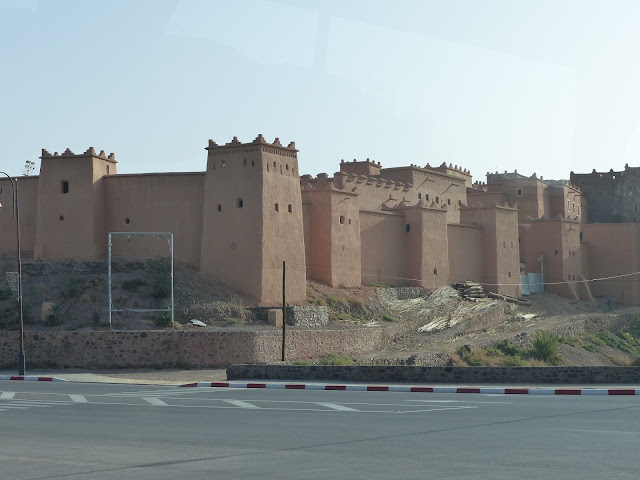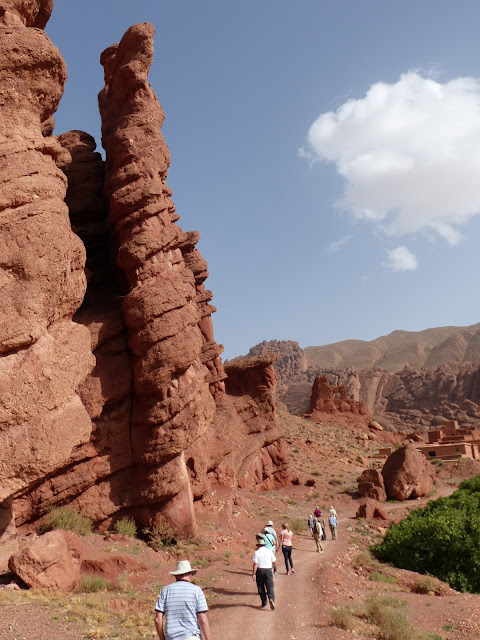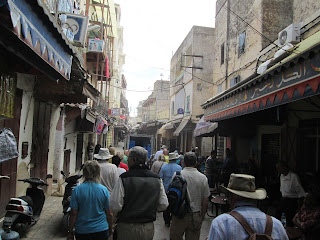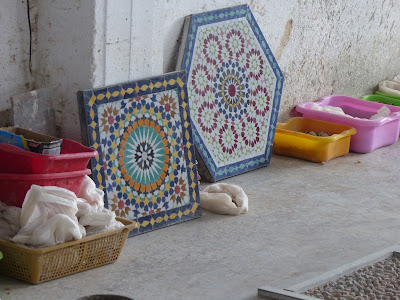 |
| Hassan II Mosque, Casablanca |
Tom and I joined a National Geographic tour to Morocco in October. They called the trip "Moroccan Odyssey" and I decided to keep the name. It was a very interesting trip - so different than anywhere else we've been. It's definitely a third-world country. We were told not to drink the water, not to eat anything raw and not to buy food from street vendors. We did all those things and did not get sick. Remembering to use bottled water when brushing teeth is a challenge.
Entering the country, we had to complete forms with basic personal information, where we were staying, etc. I avoid using the term "housewife" as much as possible. Does Tom look like a house? I don't feel married to a house. This time I wrote "blogger" and they didn't question it! Cool!
Tom and I both took a lot of pictures - narrowing them down is difficult. I'm going to include many here. They will give an idea of the country: scenic landscapes, but also dirty, ugly areas with run-down buildings and trash on the ground; livestock in the fields and walking along in the cities; variety of modes of transportation whether safe for passengers or not; kinds of dress people wear from western to all levels of Arab coverings; mixture of modern and out-dated. What you will miss are the different smells (spices, animals, exhaust) and the sounds (calls to prayer five times daily). I've been told by some people that they like the pictures that include Tom and I the best. We made a point of taking at least one photo together each day.
Warning - this is a very long post. No obligation to read the entire thing in one sitting or ever. I'll never know the difference! I am also well aware that some of the text appears centered rather than left-justified. Why? Google is not cooperating with me! I have spent a lot of time going back to edit those sections and they won't change. Well, so be it. Some things are just not that important.
We started our tour in Casablanca, home of the third largest mosque in the world. That is the main tourist attraction in the city. The other reason to start there is because it is where it is easiest to get flights in and out. Coming from Europe, we were lucky not to have to deal with jet-lag. Everyone else except our NG (National Geographic) expert flew in from the USA.
We stayed in very nice hotels and they were each unique. The first had an open window area between the bathroom and the bedroom area - that was a first for me!
 |
| Tom sitting on the couch |

 |
| palm tree lined streets |
We had some time to explore Casablanca on our own while the others had the morning free to try to sleep off jet-lag.
We wandered around the old medina (market/shopping area).
 |
| exterior of medina |

 |
| not the clothing advertisement we're used to |
Our group was made up of 25 Americans, one NG expert who is American but lives in Norway in the summer and Morocco in the winter, a local Moroccan guide and a NG expedition leader who was responsible for all the logistics. We introduced ourselves at our first lunch together and over the tour learned much more about each other. Everyone was nice enough although there were a couple of odd characters (and they weren't us - no comments, please!).
There are many royal palaces in Morocco and tourists are not invited inside - imagine that! We were only allowed to take pictures outside the walled grounds.
 |
| first day of tour - royal palace of Casablanca |
We walked through the Habous district.
 |
| so many olives including pink ones, who knew? sadly, no taste testing since this is a street vendor! |
Finally we made it to Hassan II Mosque with the world's tallest minaret.
The people are necessary to appreciate the size of this mosque.

 |
| slightly under-dressed |
Before we left for the mosque, I was told I was slightly under-dressed. There were no clothing police like we saw in Kuala Lumpur, Istanbul or Abu Dhabi, but out of respect for our local guide and the other Moroccans, I had a scarf with me just in case. It was nice not to have to wear it covering my head.
Now for the interior:
Ornate chandeliers and ceilings

 |
| men worship below, women on the wooden balcony above |
 |
| Tom and others from the group appreciating the detailed work |
Lower level is for ablutions or baths, separate facilities for each sex
Mosaic details

Our NG expert, David Silverberg, was with us for the entire journey. He is a geologist and was able to explain how the four mountain ranges that cross Morocco were formed. (please do not ask us to repeat it, though) He is also very knowledgeable about other aspects of life in Morocco. Before we left Casablanca, David gave his first talk about the geography of Morocco. He and Mohammed, our local Moroccan guide, were a good team.
As we depart the Casablanca portion, I will quote two of our compatriots who declared that Casablanca "looked just like any European city!" Really? I totally disagree. You can judge for yourselves.
This bus was our mode of transportation for most of our travels across Morocco. We had the same driver and helper for the duration. We made frequent "comfort" stops where we would find tolerable toilet facilities. Nothing as bad as we were warned we might experience.
 |
| Nos-Nos |
David
introduced us to his favorite Moroccan coffee drink: Nos-Nos (pronounced noose-noose). It is
hot coffee and unsweetened condensed milk. When done right, it is served in layers. I definitely thought it was over-rated. It wasn't much different than the Swiss latte-macchiato, but without chocolate on top.
From Casablanca, we made our way to Marrakech, one of Morocco's four imperial cities. We visited the Saadian Tombs which include more than 60 royal tombs primarily from the 16th century. The different heights of the grave markers indicate status. Servants were also buried here.
 |
| Saadian Tombs exterior |
Arab artwork does not include any human or animal figures. All their art is either geometric, floral/plants or calligraphy.
 |
| calligraphy on grave marker |


During our time in Marrakech, we had plenty of time to explore the medina and souks with the group and on our own. It is a maze of crowded alleys with vendors trying to entice us into their shops by saying "you are welcome!" Maybe because of the hat and beard combination, Tom was often called Alibaba or Indiana Jones by the shopkeepers.
Some random, but colorful views of Marrakech:

 |
| this day was very warm so the shade was very welcome |
The hand of Fatima is considered good luck; therefore, it is seen protecting a home or business as a door knocker or in jewelry.

 |
| snake charmers |
 |
| the snakes |
 |
| lots of snakes - yuck! |
Berber water carriers dressed like this. Now they hope you'll take their picture and give them some coins in return. I didn't really want to wear this hat, but I wasn't asked.
 |
| narrow streets with plenty of motorcycles |
I bought this red "dress" with the hand of Fatima because I thought it'd make a decent nightgown. I left mine in the hotel in Casablanca! That's a first for me and I can't believe I'm admitting it. The shopping was definitely worth it because the vendor and Tom had a good time too.
 |
| Alibaba and friend |
 This lunch was very typical. We were served many small dishes of vegetables and olives as a starter, along with bread, of course. If it wasn't this, it was a "cooked salad" of tomatoes, zucchini and eggplant. Similar to ratatouille with different spices.
Tanjines are the ceramic pot that is used to cook the food slowly over low heat. They are also brought to the table to serve the food. (We actually saw some men cooking in one on the side of the street!) The meats we were served were either chicken or lamb.
This lunch was very typical. We were served many small dishes of vegetables and olives as a starter, along with bread, of course. If it wasn't this, it was a "cooked salad" of tomatoes, zucchini and eggplant. Similar to ratatouille with different spices.
Tanjines are the ceramic pot that is used to cook the food slowly over low heat. They are also brought to the table to serve the food. (We actually saw some men cooking in one on the side of the street!) The meats we were served were either chicken or lamb.
 |
| vegetable tanjine |
 |
| lamb chops and sausages |
 Marrakech hotel by day and by night
Marrakech hotel by day and by night
 |
| water carrier in lobby |
 |
| hotel grounds from our private terrace |
This is definitely not your average hotel elevator!

 |
| sunset over hotel grounds |
 |
| evening view of Marrakech - everyone is "connected" by satellite dish |
 |
| fancy tanjine used to serve dinner |
Bahia Palace - built at the end of the 19th century

 |
| detailed view |
 |
| ceilings were amazing |
 |
| another ceiling |

wooden ceiling detail
 |
| walk-in fireplace! |
 |
| at Bahia Palace |
 We
visited Jardin Majorelle which is a small botanical garden of cactus
and other plants that grow in a desert environment. While the plants
themselves were interesting, the Berber Museum housed in a building on the property was the highlight for me. We were able to see the local
costumes and jewelry. The Berber region covers quite a large area so
there was extensive variety. No photos allowed, however. Guess who
bought some postcards?
We
visited Jardin Majorelle which is a small botanical garden of cactus
and other plants that grow in a desert environment. While the plants
themselves were interesting, the Berber Museum housed in a building on the property was the highlight for me. We were able to see the local
costumes and jewelry. The Berber region covers quite a large area so
there was extensive variety. No photos allowed, however. Guess who
bought some postcards?
 |
| does the hat look familiar? |
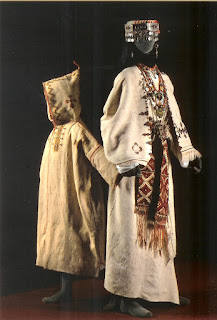

 |
| hand of Fatima again |
It is still common practice for women to carry their bread dough to a community oven for baking. They return later in the day to collect it.

 |
| woman carrying her dough to the oven |
 |
| finished loaves |
We actually had a taste of bread from this oven. I was very hesitant because "how is this different from street food?" Our tour guide encouraged us so I took a tiny piece hoping any germs had been killed in the oven. The bread was still warm, but nothing special. Neither of us got sick.
 Ben Youssef Madrasa is an Islamic college founded in the 14th century. The buildings we toured did not look special from the exterior. There are no windows to the street because they didn't want people to look inside and see what might be there. There are usually large courtyards and any windows open to the courtyard. There is plenty of light, just not from the street.
Ben Youssef Madrasa is an Islamic college founded in the 14th century. The buildings we toured did not look special from the exterior. There are no windows to the street because they didn't want people to look inside and see what might be there. There are usually large courtyards and any windows open to the courtyard. There is plenty of light, just not from the street.
 |
| main courtyard |
 |
| dormitory rooms surround another roof opening |
 |
| huge "necklace" |
With our free time in Marrakech, we took our NG expert's advice and went to an artisanal shopping area. There were many kinds of crafts represented and there was no bargaining. I realize that is part of the culture, but we do not enjoy the haggling. If you don't do it in the other shops, you are guaranteed to over-pay.
 |
| Ensemble Artisanal |
 |
| lots of unique instruments |
 |
| foot assists woodworker |
 |
| he made this piece in only a few minutes |
This is probably not very surprising: a chess set made its way home to Switzerland with us. The black squares are burnt lemon wood and the brown squares are ash. The pieces are lemon wood, with the dark pieces stained.
We made a brief stop in the Photography Museum of Marrakech. It was interesting to see photos of local people from many years ago.
 |
| 1930 |
 |
| 1930 |
 |
| 1920 - not so different in the desert now |
 |
| I'm glad we didn't have to sit right on the desert sand! |
Exposed skin tells us this is a Jewish woman.
 |
| 1880 |
 |
| Arab woman - 1920 |
 |
| 1880 |
 |
| 1916 |
 |
| same square, modern view thanks to google |
 |
| hotel pool was a delight after a very warm day spent touring and shopping |
 |
| 4x4s |
After departing Marrakech, we crossed the High Atlas Mountains. Because of the terrain, we rode part of the way in a caravan of 4x4s.
During this drive, we followed the road of 1,000 kasbahs (fortresses) which is also the old trade route. Luckily, we only stopped at a few kasbahs, but we saw the remnants of many abandoned others.
 |
| Kasbah of Telouet in disrepair - former home of Glaoui clan - abandoned in 1956 |
 |
| part of interior survives |
 |
| view from kasbah |
 |
| livestock and 4x4s below |
National Geographic made arrangements for us to have tea at a local family's home. They are also renting out rooms as a small B&B.

 |
| the tea tasted terrible to me |
The daughter is
14 years old and stopped going to school after the 6th grade primarily
because it is so far away. She is being prepared for marriage which is very common in this region of Morocco.
There were many interesting sites along our ride. Taking pictures from a moving vehicle is quite challenging, but since Tom took many pictures, we got some good ones!
 |
| prickly pears growing everywhere! |
 |
| olives |
 |
| doesn't look like much, but satellite dishes tell you people do live here. |
 |
| Moroccan mountains are different than Swiss, but still beautiful |
 |
| you can see why we needed 4x4s |
 |
| back in the car! |
Our vehicle had seating for six and lucky for us, our NG expert was in our vehicle. I sat in the seat farthest back for most of the time. My knees actually bothered me by the end of the day from being unable to straighten my legs! Tom only had a short stint in the back.
 |
| shielding their faces from the camera |
 |
| one of many kasbahs along the way |
 |
| goats and sheep grazing |
Lots of donkeys live and work in Morocco.
 |
| government reforestation |
 |
| the white on the hillside is salt |
 |
| camels live and work here too |
 Our next stop was the ancient fortified village of Ait Benhaddou. Parts date back to the 11th century, but other parts are younger. We walked across the bridge (sometimes there is water in this river bed) and through the narrow streets to the upper levels. This area is now a tourist attraction because it has been used as the set of several movies including Lawrence of Arabia and the Asterix and Obelix "Mission Cleopatra" film.
Our next stop was the ancient fortified village of Ait Benhaddou. Parts date back to the 11th century, but other parts are younger. We walked across the bridge (sometimes there is water in this river bed) and through the narrow streets to the upper levels. This area is now a tourist attraction because it has been used as the set of several movies including Lawrence of Arabia and the Asterix and Obelix "Mission Cleopatra" film.
 |
| Ait Benhaddou with movie set on the far right |
 |
| it was incredibly windy on the top! |
 |
| view from the top |
 |
| musician along the way |
There were shops and entertainers along our walk. Tourism is obviously a big part of the local economy.
 There were also some old movie props in the hotel (Le Berbere Palace).
There were also some old movie props in the hotel (Le Berbere Palace).
 |
| from Asterix and Obelix |

We only stayed one night in Ouarzazate, but as it is home to a university, we had the opportunity to meet some students and also two members of the Peace Corps. We were able to chat before and during dinner. One of the young women, Fatima, was 21. Her father is a teacher and encourages her to continue her studies. Another of the young women was only 20 years old, but has already been married 3 years! Her husband lives in Casablanca because that's where the job is and she lives here. I asked her if she knew her husband before the wedding and she said yes. I learned later that the marriage had been arranged so she didn't know him for very long. We were surprised how excited they were about having their picture taken. We had been told never to take pictures of individuals without their permission first. Some people believe part of their soul is taken from them when a picture is taken. Taking a picture of a street scene that happens to have people in it is not a problem. Here, the waiter even joined the picture.
 |
| Fatima is in the stripes |
The students are frustrated because their teachers are not dedicated. They are studying English (which was already very good), but as of this date in early October, the professor had not come to class since the semester began! Fatima's English was so good that she even used common American expressions: whatever, like, and my bad! She said she learned a lot of her English from watching TV. Her education still needs work because when we told her we were living in Switzerland she said she had no idea where that is.
Departing Ouarzazate, we continued along the road of 1,000 Kasbahs, stopping first at Kasbah Taourirt, a former el Galoui (family name) palace.
Moroccans sure love their ceilings.
 |
| with local guide |
 We
had both lunch and dinner at our hotel, Xaluca Dades, which I liked
because it was not only convenient, but had very nice decor in the restaurant. The hotel room
amused me with what I call the "bunk bed" closet with the safe sitting
on the top shelf.
We
had both lunch and dinner at our hotel, Xaluca Dades, which I liked
because it was not only convenient, but had very nice decor in the restaurant. The hotel room
amused me with what I call the "bunk bed" closet with the safe sitting
on the top shelf.
 |
| hotel restaurant |
 I learned that dates grown on palm trees. Guess what they're called? Date palms - good name!
I learned that dates grown on palm trees. Guess what they're called? Date palms - good name!
 |
| Jewish Cemetery |
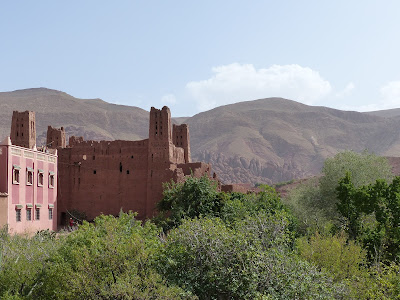 A couple more Kasbahs along the way. I'm sure you're glad we're not including all 1,000! We're actually glad we didn't see all of them or their remains!
A couple more Kasbahs along the way. I'm sure you're glad we're not including all 1,000! We're actually glad we didn't see all of them or their remains!
 We took a short bus ride to have a walk in the Dades Gorge. People are in some of the pictures to show the size of the rock formations. Our NG expert did his best to explain to us what we were looking at and I have since forgotten most of it. He was often heard to say "it's really quite fantastic!"
We took a short bus ride to have a walk in the Dades Gorge. People are in some of the pictures to show the size of the rock formations. Our NG expert did his best to explain to us what we were looking at and I have since forgotten most of it. He was often heard to say "it's really quite fantastic!"
 |
| figs left to dry in the sun |
 |
| kasbah and landscape at a photo stop on the way back to the hotel |
 |
| hotel welcoming party |
More pictures thanks to Tom's fast reactions to sights outside the bus window:
 |
| that's a lot of goats! |
 |
| camels |
 |
| more camels |
 |
| roadside laundromat? |
 |
| seat-belts everyone? |

 |
| bicycle repair shop |
 |
| I'm glad I don't have to use my head to transport goods. |
 |
| well |
 |
| sheep crossing |
 Lunch stop at this Pizzeria Restaurant. Nice change from the usual offerings.
Lunch stop at this Pizzeria Restaurant. Nice change from the usual offerings.
 |
| Moroccan pizza |
Fruit dessert which I did not eat, but an interesting way to serve pomegranate.
We made a stop in Rissani, an historical major caravan center, walking around its souk. We did not buy any livestock although the opportunity was there!
 |
| Rissani street view |
 |
| meat for sale swarming with flies!!! |
 |
| scarf purchases made here |
We were encouraged to purchase head scarves to protect us from the desert wind and sand. Our guide negotiated a great price: about $3 each.
The spices are very often displayed out in the open, totally exposed. They look pretty, but unappealing at the same time.
 |
| sheep market |
 |
| anyone want a donkey? |
 |
| chickens - for eating or eggs? unknown |
 |
| watering the dusty road |
 Sign says no parking for horse and cart, but look who is parked there?
Sign says no parking for horse and cart, but look who is parked there?
 Earlier, our Moroccan guide had explained to us the prayer ritual and
we often heard the calls to prayer. Here we happened to see men in
prayer, exactly demonstrating what we'd been told. I must admit to being
confused about the one man facing in the opposite direction. (They are
in front of a building with a painted mural.) It is not unusual to see someone alone in prayer outside.
Earlier, our Moroccan guide had explained to us the prayer ritual and
we often heard the calls to prayer. Here we happened to see men in
prayer, exactly demonstrating what we'd been told. I must admit to being
confused about the one man facing in the opposite direction. (They are
in front of a building with a painted mural.) It is not unusual to see someone alone in prayer outside.
 |
| old caravan town |
The rock in Tom's hand is black on the top, where the sun has hit it for years, and brown on the unexposed bottom.
 After we finished our visit in Rissani, we once again boarded 4x4s. This time we needed them because our destination was our tent camp for the night in the Sahara. Our driver was a bit rogue and didn't want to be last. He did not always follow the path of those in front, but made his own way - there are no roads. It was definitely a bumpy ride.
After we finished our visit in Rissani, we once again boarded 4x4s. This time we needed them because our destination was our tent camp for the night in the Sahara. Our driver was a bit rogue and didn't want to be last. He did not always follow the path of those in front, but made his own way - there are no roads. It was definitely a bumpy ride.
 |
| camels and drivers waiting at the camp |
 |
| always a welcome with (sometimes gross) tea |
 |
| tent gathering area without people - Tom must have chased them away! |
 |
| hallway between tents |
 |
| our accommodations for the night |
 |
| Alibaba! |
 |
| ready for our ride into the desert |

 |
| camels and desert await |
For those camping fans out there, you can see behind me that our tent had indoor plumbing! Camp style shower, sink and toilet all good unless you need them after 10 pm when the generator was turned off for the night. We were very glad to have them!

 |
| I'm on the lead camel! |
The goal of this excursion was to reach a good vantage point for watching the sun set on the desert. It wasn't only an exotic "pony ride".
 |
| Ready to go! Tom stands out in red! |
 |
| follow the leader |
 |
| my camel and driver - we're not leading anymore |
I had to stop because the person on the camel behind me was about to slide off. Adjustments needed to be made and then we started again. The group did not wait for us. How rude! We were leaders and ended up being the caboose.
 |
| me and my faithful "steed" |
 |
| Our camels are way down there! Wasn't so easy to climb up the dunes! |
 Sunset over the sand dunes.
Sunset over the sand dunes.
While we were out waiting for the sun to set, some folks noticed a storm cloud. Our Moroccan guide was asked if the storm was headed our way. He confidently answered that it would blow in another direction. He was wrong! The sand storm came right at us. Most of us were very thankful we took the advice and bought head scarves. The one who did not...well, he didn't complain. The sand is very fine and was everywhere. It felt great to use the little camp shower to get at least most of it off. During the night, it was still very windy and sand kept falling from our tent ceiling. Not so pleasant and not so easy to sleep. Many people mentioned having turned their pillow over during the night to use the sand-free side. I wish I'd thought of that.
 |
| sunrise |
 Some of us got up early the next morning to walk up into the dunes to see the sun rise. It wasn't a very restful place to sleep, so there was no incentive to stay in bed anyway! It was much colder than the night before and we were glad to have layers to wear.
Some of us got up early the next morning to walk up into the dunes to see the sun rise. It wasn't a very restful place to sleep, so there was no incentive to stay in bed anyway! It was much colder than the night before and we were glad to have layers to wear.
 |
| windy, but much less sand flying |
 |
| dunes with morning light |
 We had breakfast at our tent camp (some people complained about sand in the eggs, but I did not experience that, luckily) and got back in the 4x4s to head out of the desert. We made it back to our bus and began a long drive to Fez.
Did I happen to mention that the desert sand got EVERYWHERE? Notice the brown on the edges of the luggage tag - that's inside the plastic!!
We had breakfast at our tent camp (some people complained about sand in the eggs, but I did not experience that, luckily) and got back in the 4x4s to head out of the desert. We made it back to our bus and began a long drive to Fez.
Did I happen to mention that the desert sand got EVERYWHERE? Notice the brown on the edges of the luggage tag - that's inside the plastic!!
During our longer bus rides, our NG expert and Moroccan guide gave us mini-lectures which helped ease the boredom of the ride. We learned a lot about the history and politics of Morocco, the Islam religion and much more. Our NG expert also read aloud some short stories set in Morocco. He is an excellent reader and the stories were very enjoyable.
Interior of our lovely lunch spot
 Waiting to get back on the bus to continue our journey, I walked around a small square multiple times - just to get the blood moving. I have no idea why the park had a lion carved from stone.
Waiting to get back on the bus to continue our journey, I walked around a small square multiple times - just to get the blood moving. I have no idea why the park had a lion carved from stone.
 |
| out of the desert |
 |
| sheep are finding what little vegetation there is |
 Another stop along the way to Fez was to walk through a cedar forest. Looks a bit like New England!
Another stop along the way to Fez was to walk through a cedar forest. Looks a bit like New England!
 |
| Zurich insurance is worldwide! |
For our stay in Fez, we were led by a local guide who knew his way around the narrow and winding alleyways. We started with a walk through the Mellah, or Jewish Quarter.
First stop, the synagogue. It doesn't look like much from the outside.
 |
| our guide, "Moomoo" shows us the ancient torah behind the curtain |
 |
| rabbi's chair |
 |
| view from above |
 |
| women's synagogue was upstairs |
 |
| cemetery |
Of course, there had to be a Royal Palace in Fez like every other city. Again, tourists are only permitted to photograph the walls and gates. No picture taking of guards because they fear someone will copy the uniforms and disguise themselves as guards.

 Even the streets of Fez have architecture like palaces!
Lunch at the beautiful Palais Medina restaurant.
Even the streets of Fez have architecture like palaces!
Lunch at the beautiful Palais Medina restaurant.

 Following our guide through the labyrinth of Fez, we had to walk single file and be mindful of the donkeys that might appear around the next corner!
Following our guide through the labyrinth of Fez, we had to walk single file and be mindful of the donkeys that might appear around the next corner!
 Many doors are actually a door within a door. Whether the large or small door was opened for you depended upon your status. There was a different knocker (with different sound) for each of the doors.
Many doors are actually a door within a door. Whether the large or small door was opened for you depended upon your status. There was a different knocker (with different sound) for each of the doors.
 |
| unique way to make crepes |
We visited Kairaouine Mosque which houses the world's oldest university. It is still a spiritual and intellectual center of Islam.
 |
| central courtyard with ablutions basin |
 |
| one speaks facing the wall and the voice is amplified |
 |
| dormitories above |



We were exploring unknown territory and not always quite sure what to expect. At two meat stands we came face to face with dead animal heads! This is supposed to prove what kind of meat was there. One was a cow head and one a camel - each time was very startling. (Sparing you the visual experience.)
One of the constant surprises was the extreme contrast between a building exterior and interior. Here we are entering a carpet showroom. They explained about the different designs and materials and of course concluded with a heavy sales pitch.
 |
| carpet showroom |
 |
| want to buy a fez? |
Surprisingly, the fez hats weren't for sale everywhere. This vendor made at least one sale from our group.
 Moomoo explains about this cooking device which was being made at this shop.
Moomoo explains about this cooking device which was being made at this shop.
 |
| willing to be photographed ... for a small fee |
 |
| under renovation |
Fez is known as a center for tanning and making leather goods. I think it was to our advantage that the tannery was under renovation. It would have been horribly smelly. Instead, there was a video of what normally takes place outside the window of the leather showroom.
Some pictures from the video:
Inside there seems to be an infinite amount of leather goods for sale. I was not able to leave this place without a purchase or two!
 |
| that's a lot of shoes! |
Some of us took the opportunity to go to a pottery workshop and showroom. All stages of production were being demonstrated and explained on site.
 |
| tanjines in progress |

 |
| hand painted |
 |
| special brush has longer bit in center in order to paint fine details |
I found the process for putting together mosaics fascinating. The pieces are only colored/painted on one side. The are laid into the form color side down! I thought that wasn't so bad. Each color must only be a certain shape and that is how it could be remembered. Wrong! The artist must remember the intended pattern and what was placed last. Some pieces take days or weeks to create and there is no way to check. Wow! Even more appreciation for the art now.
 |
| cutting mosaic pieces |
 |
| mosaic pieces |
When the mosaic is finished, the pieces will then be covered with more clay to hold it all together.
The finished products are beautiful!
 |
| crazy traffic patterns - cars and pedestrians! |
 |
| hotel restaurant's musician |
 Our last full day we were given the choice to go back into Fez or go to the Roman ruins of Volubilis. We chose the latter and it was definitely reminiscent of the Forum in Rome although bigger than what I remember from Rome. We had an early departure to get here before the crowds - it was well worth the effort.
Our last full day we were given the choice to go back into Fez or go to the Roman ruins of Volubilis. We chose the latter and it was definitely reminiscent of the Forum in Rome although bigger than what I remember from Rome. We had an early departure to get here before the crowds - it was well worth the effort.
 |
| from a distance |
 The floors of the old structures had intricate mosaics.
The floors of the old structures had intricate mosaics.

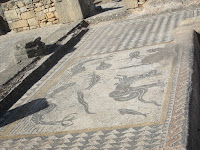

 |
| intricate stonework! |
 |
| doorway structure reminds me of Malta |

 |
| ancient road |
 |
| Farewell Volubilis |
Here is our NG expeditions leader, "JD", in a stress-free moment. He was a vital part of the success of the trip: he was in contact with each hotel or restaurant before our arrival, he carried extra listening devices (the fancy necklaces you saw us wearing) and batteries, he made sure everyone was back on the bus before departure and much more. On top of all that, he was a genuinely nice guy.
After Volubilis, we spent our last Moroccan afternoon in Meknes, the 17th century capital.
 |
| main square of Meknes |
Moulay Ismail, a former sultan, was responsible for building projects in Meknes and also robbing the ruins of Volubilis which helped raise the status of Meknes to an imperial city. We visited the granary and its stables.
 |
| white spots are all garbage |
Beside the tourist attractions and local color, one constant on the trip was garbage. Morocco has a definite problem with people littering. Empty plastic bags blow in the breeze. Trash is along all main roadways. It appears that they don't recycle plastic bottles - the empties are everywhere! What a shame.
 |
| garbage is not scenic |
Here is our whole group - a nice size for easy travel. Mohammed, our Moroccan who accompanied us the whole trip, is squatting on the right. NG expert, David, holds left end of the banner. "JD" took the photo!
As we were waiting in the queue at passport control in Casablanca to leave the country, my person left his booth and told me to go to another line! What? I'm next. At least I didn't have to get in the end of that line. After I got through, I saw him kneeling and praying in the corner! That was a first.
 We always enjoy seeing the easily recognizable stop sign with languages other than English. It also seems a fitting way to end this extremely long post. Anybody bleary-eyed? Congratulations to those of you who made it to the end. There is no prize except that you're done!
We always enjoy seeing the easily recognizable stop sign with languages other than English. It also seems a fitting way to end this extremely long post. Anybody bleary-eyed? Congratulations to those of you who made it to the end. There is no prize except that you're done!












